The National Portrait Gallery’s signature installation, America’s Presidents, is the only public collection to feature portraits of all of the U.S. presidents.
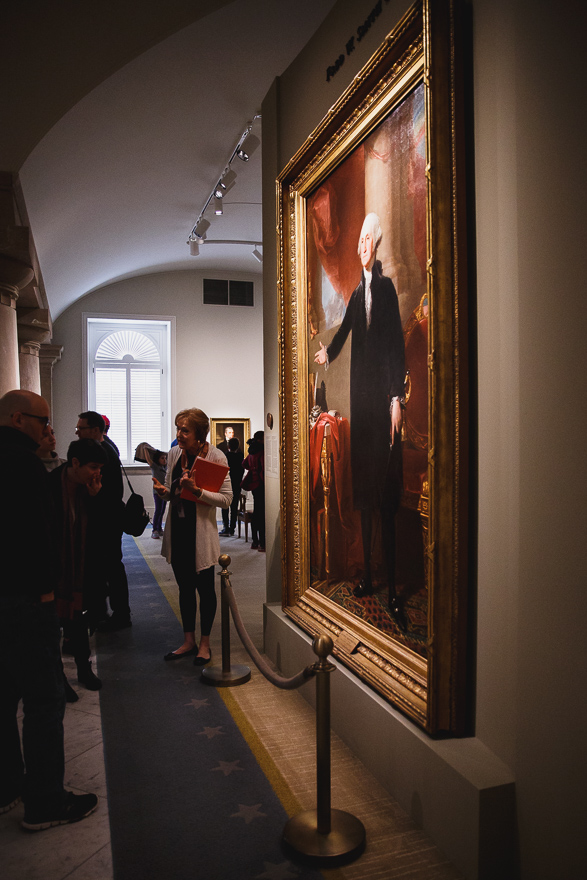 As he mapped out the composition for this painting, American artist Gilbert Stuart, who had previously worked in England and Ireland, drew from European traditions of state portraiture to evoke Washington’s military and civic leadership. The artist made a number of direct references to the newly formed United States, and the pose he chose for the president is believed to allude to Washington’s annual address in front of Congress in December 1795.
As he mapped out the composition for this painting, American artist Gilbert Stuart, who had previously worked in England and Ireland, drew from European traditions of state portraiture to evoke Washington’s military and civic leadership. The artist made a number of direct references to the newly formed United States, and the pose he chose for the president is believed to allude to Washington’s annual address in front of Congress in December 1795.  James Buchanan came to the presidency hoping to quiet tensions between pro- and anti-slavery states. Instead, animosities deepened under his leadership. Two days after his inauguration, the Supreme Court ruled in the Dred Scott case that Congress could not prohibit the practice of slavery in any territory. By the end of his term, antagonism between the North and the South waxed ever stronger, and the long-feared specter of civil war was turning into a reality. During the “Secession Winter,” which followed Lincoln’s election in 1860, Buchanan did nothing to prevent the first Southern states from seceding, and his haplessness has cemented his reputation as arguably one of the country’s least effective presidents.
James Buchanan came to the presidency hoping to quiet tensions between pro- and anti-slavery states. Instead, animosities deepened under his leadership. Two days after his inauguration, the Supreme Court ruled in the Dred Scott case that Congress could not prohibit the practice of slavery in any territory. By the end of his term, antagonism between the North and the South waxed ever stronger, and the long-feared specter of civil war was turning into a reality. During the “Secession Winter,” which followed Lincoln’s election in 1860, Buchanan did nothing to prevent the first Southern states from seceding, and his haplessness has cemented his reputation as arguably one of the country’s least effective presidents. George Peter Alexander Healy painted a life portrait of Lincoln in 1860, but he had to rely on other portraits to make this image, one of four he created after Lincoln’s death. All are derived from Healy’s 1869 group portrait The Peacemakers, which features the president, Generals William T. Sherman and Ulysses S. Grant, and Admiral David D. Porter as they discuss strategy near the end of the Civil War.
George Peter Alexander Healy painted a life portrait of Lincoln in 1860, but he had to rely on other portraits to make this image, one of four he created after Lincoln’s death. All are derived from Healy’s 1869 group portrait The Peacemakers, which features the president, Generals William T. Sherman and Ulysses S. Grant, and Admiral David D. Porter as they discuss strategy near the end of the Civil War. 
In February of 1865, just two months before Abraham Lincoln’s assassination, Alexander Gardner created this “cracked-plate” portrait, now considered one of the most important and evocative photographs in American history. Deep, dark grooves in Lincoln’s skin may evoke his weariness at the end of the Civil War, but he also exhibits a slight smile—perhaps a sign of relief as the restoration of the Union draws near. Lincoln had looked forward to continuing his presidency but died only weeks after beginning his second term.
At some point, possibly when the glass-plate negative was heated to receive a coat of varnish, a crack appeared in the upper half of Gardner’s plate. He made a single print and then discarded the damaged plate, so only one such portrait exists.
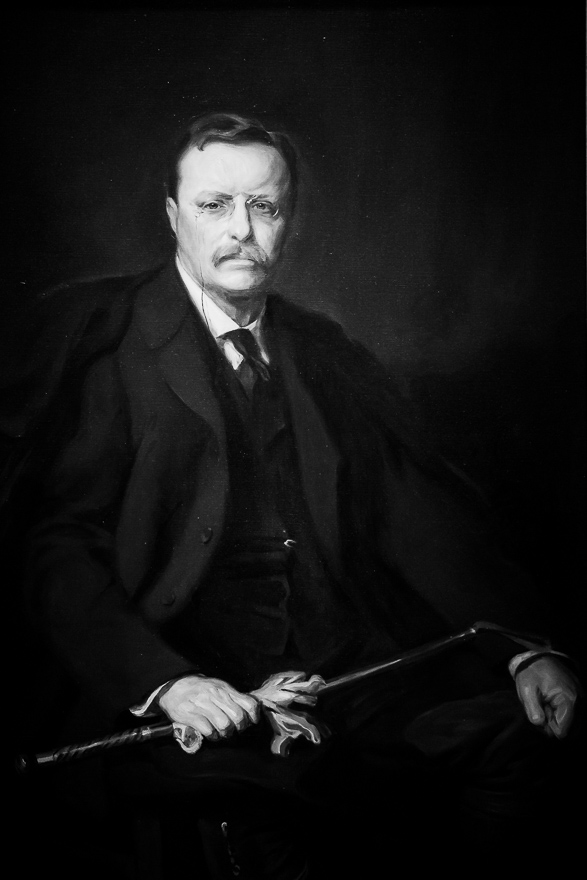
An outsize personality who preached the benefits of the “strenuous life” while also being among the most learned of presidents, Theodore Roosevelt gained national prominence as a civil service reformer, a hero of the Spanish-American War, and a proactive governor of New York. After William McKinley was assassinated in 1901, Roosevelt took office and initiated one of American history’s most reform-oriented presidencies. His contributions would include implementing efforts to conserve the nation’s disappearing natural heritage, instituting some of the first significant curbs on the excesses of big business, and building the Panama Canal.
Despite having progressive views on labor and consumer issues, Roosevelt maintained conservative views on a number of social issues. For example, he felt convinced that a declining birthrate among old-stock Americans threatened the nation as a whole and therefore opposed immigration, birth control, and the redefinition of women’s roles.
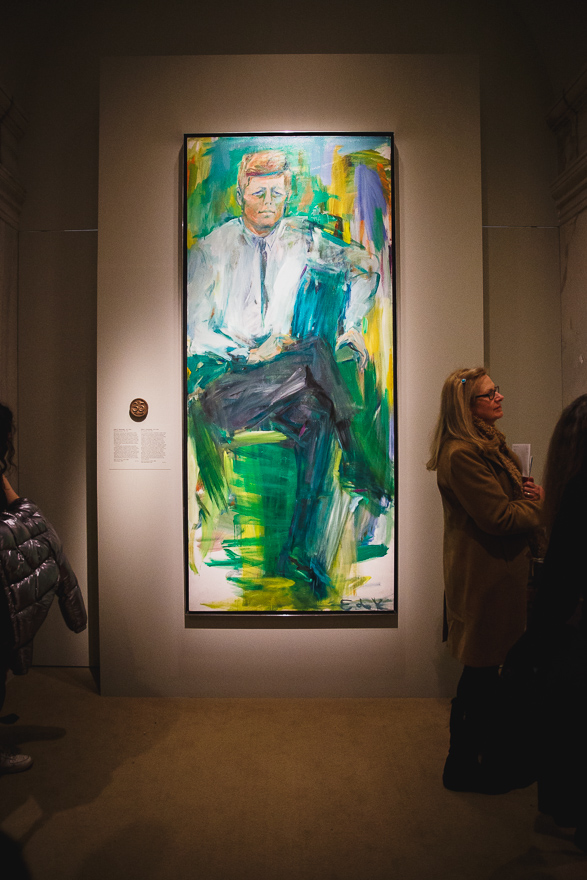 Elaine de Kooning, known for her gestural portraits, created this portrait of Kennedy for the Truman Library. She held several informal sessions with him in Palm Beach, Florida, in December 1962 and January 1963. When Elaine de Kooning met with John F. Kennedy she made a number of small drawings of his features. Some of her images depict the president’s entire face, but others focus primarily on his eyes. She noted, “you never know where ‘likeness’ will reside,” adding, “It would be possible to portray the man by drawing or painting only his eyes, so that he would be recognized instantly.”
Elaine de Kooning, known for her gestural portraits, created this portrait of Kennedy for the Truman Library. She held several informal sessions with him in Palm Beach, Florida, in December 1962 and January 1963. When Elaine de Kooning met with John F. Kennedy she made a number of small drawings of his features. Some of her images depict the president’s entire face, but others focus primarily on his eyes. She noted, “you never know where ‘likeness’ will reside,” adding, “It would be possible to portray the man by drawing or painting only his eyes, so that he would be recognized instantly.”
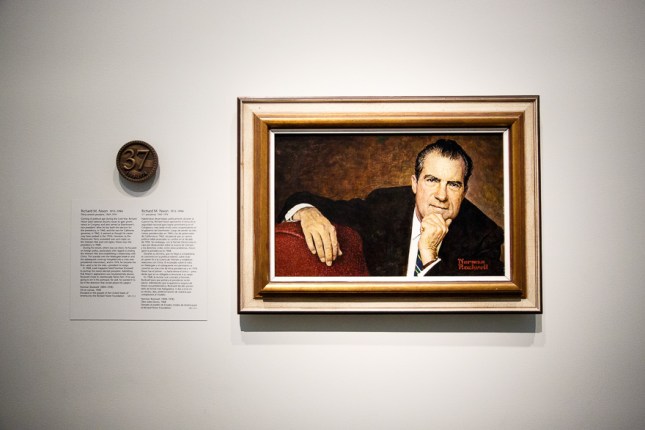 In 1968, Look magazine hired Norman Rockwell to portray the newly elected president. Admitting that Nixon’s appearance was troublesomely elusive, Rockwell chose to intentionally flatter him. If he was going to err in his portrayal, he said, he wanted it to be in the direction that would please his subject.
In 1968, Look magazine hired Norman Rockwell to portray the newly elected president. Admitting that Nixon’s appearance was troublesomely elusive, Rockwell chose to intentionally flatter him. If he was going to err in his portrayal, he said, he wanted it to be in the direction that would please his subject. 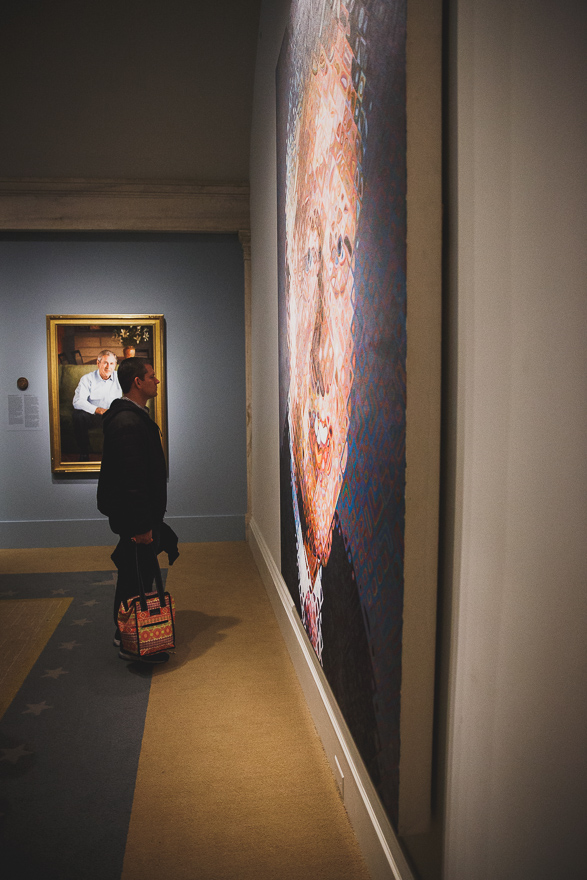 Near: Chuck Close begins all of his paintings by taking a photograph of his subject, in this case an image of Clinton made during a photo session in August 2005 for a New York magazine cover. He then creates grids on both the canvas and the photograph to replicate the information contained in the photograph with a series of abstract modules.
Near: Chuck Close begins all of his paintings by taking a photograph of his subject, in this case an image of Clinton made during a photo session in August 2005 for a New York magazine cover. He then creates grids on both the canvas and the photograph to replicate the information contained in the photograph with a series of abstract modules.
Far: Bush selected Robert Anderson, a Connecticut portraitist and a Yale classmate of his, to create this painting for the National Portrait Gallery. The president requested an informal image and posed at Camp David, the presidential retreat in Maryland.  Artist Kehinde Wiley is known for his vibrant, large-scale paintings of African Americans posing as famous figures from the history of Western art. This portrait does not include an underlying art historical reference, but some of the flowers in the background carry special meaning for Obama. The chrysanthemums, for example, reference the official flower of Chicago. The jasmine evokes Hawaii, where he spent the majority of his childhood, and the African blue lilies stand in for his late Kenyan father.
Artist Kehinde Wiley is known for his vibrant, large-scale paintings of African Americans posing as famous figures from the history of Western art. This portrait does not include an underlying art historical reference, but some of the flowers in the background carry special meaning for Obama. The chrysanthemums, for example, reference the official flower of Chicago. The jasmine evokes Hawaii, where he spent the majority of his childhood, and the African blue lilies stand in for his late Kenyan father. 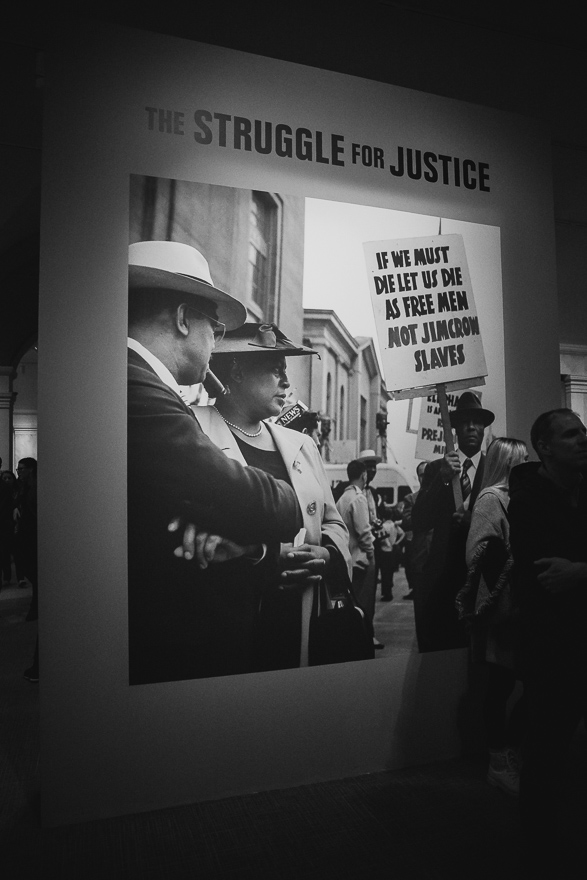
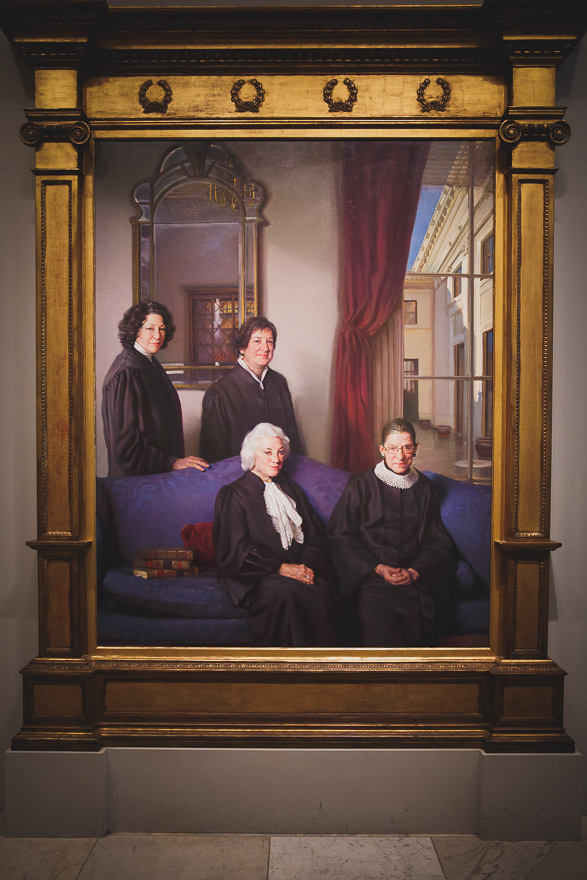 On October 28, 2013, the National Portrait Gallery celebrated the arrival of Nelson Shanks’s The Four Justices, a tribute to the four female justices who have served on the U.S. Supreme Court.
On October 28, 2013, the National Portrait Gallery celebrated the arrival of Nelson Shanks’s The Four Justices, a tribute to the four female justices who have served on the U.S. Supreme Court. 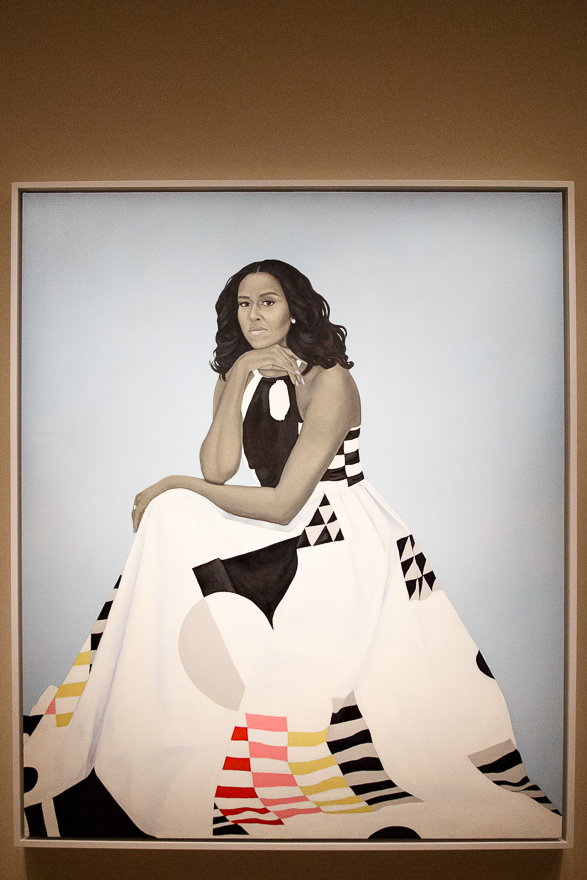 The former First Lady Michelle Obama’s decision to commission the Baltimore painter Amy Sherald for her official portrait was intriguing. Like the former President Barack Obama’s choice of the painter Kehinde Wiley for his own portrait, it was a demonstration of discriminating taste. Sherald and Wiley, the first black recipients of commissions from the National Portrait Gallery, are artists with points of view.
The former First Lady Michelle Obama’s decision to commission the Baltimore painter Amy Sherald for her official portrait was intriguing. Like the former President Barack Obama’s choice of the painter Kehinde Wiley for his own portrait, it was a demonstration of discriminating taste. Sherald and Wiley, the first black recipients of commissions from the National Portrait Gallery, are artists with points of view.
Obama sits against sky-blue oblivion, the triangular shape of the dress turning her into a mountain. To Sherald, the photorealistic depiction of race—a quality determined by others’ eyes, externally—is a dead end. Applied to Michelle Obama, the lack of brown in the skin feels first like a loss, and then like a real gain. This is a different Michelle, a woman evacuated of celebrity, who appears provisionally dreamlike, nearly a shadow. To some, the lack of racial verisimilitude may be intolerable. And yet this is how the subject would like posterity—young black girls especially, she said in a speech—to see her, through Sherald’s vision: as a herald of success.
Sources: americaspresidents.si.edu, http://www.newyorker.com
Tagged: art, National Portrait Gallery, Obama, photography, portrait, Presidents, Washington D.C.